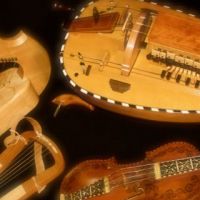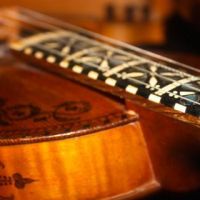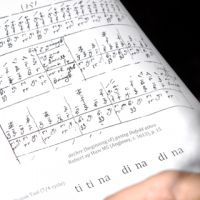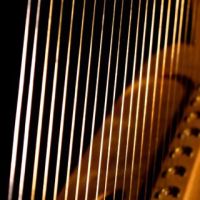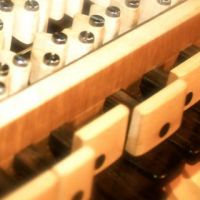
Spellweaving: Ancient music from the Highlands of Scotland
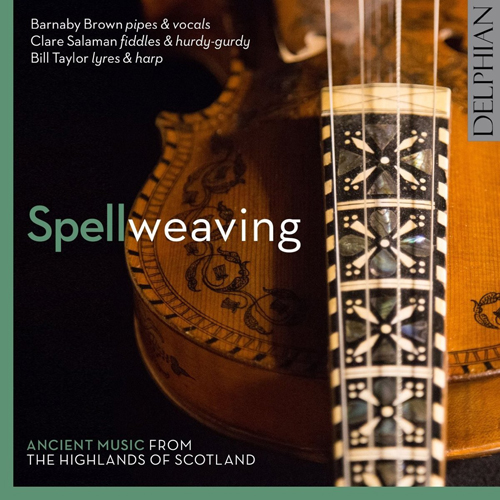 Spellweaving is the first of a 5 CD series born from a collaboration between the University of Huddersfield, EMAP, and Delphian Records, with funding support coming from all three, co-produced by Rupert Till.
Spellweaving is the first of a 5 CD series born from a collaboration between the University of Huddersfield, EMAP, and Delphian Records, with funding support coming from all three, co-produced by Rupert Till.Rupert Till came up with the idea, and he and Paul Baxter of Delphian Records have been instrumental in creating the CDs.
The first CD is now on sale, through record shops, at the EMAP Exhibition and through online sources such as Spotify, Amazon and iTunes.
Barnaby Brown, Clare Salaman, Bill Taylor
Worried that the classical music of the Gaels would fade away, the English-speaking gentry offered prize money for scientific notations. By 1797, Colin Campbell had written 377 pages in a unique notation based on the vocables of
Hebridean ‘mouth music’, but – unintelligible to the judges in Edinburgh – Campbell’s extraordinary work of preservation has remained overlooked or misunderstood until now. Barnaby Brown’s realisations bring the musical craftsmanship of a remote culture vividly to life, giving a voice back to some of Europe’s most illustrious ancient instruments and refocusing attention on a type of music whose trance-inducing long spans and elaborate formal patterning echo the knots and spells of Celtic culture.
There are 8 Tracks.
1 Hindorõdin hindodre: One of the Cragich (a ‘rocky’ pibroch) PS 53 Ùrlar | A’ Chiad Siubhal S & D | Taoludh Gearr | Crunnludh Fosgailte | Ùrlar
2 Cumha Mhic Leòid (McLeod’s Lament) PS 135 Ùrlar|A’ChiadSiubhalS&D|Ùrlar|BarrludhS&D|Ùrlar
3 Fear Pìoba Meata (The Timid Piper) PS 103 Ùrlar | Dùblachadh | Ùrlar
4 Cruinneachadh nan Sutharlanach (The Sutherlands’ Gathering) PS 72 Ùrlar|A’ChiadSiubhalS&D|Ùrlar|TaoludhS&D|Ùrlar
5 Hiorodotra cheredeche (a nameless pibroch) PS 126 Ùrlar | A’ Chiad Siubhal S & D | Ùrlar
6 Port na Srian (The Horse’s Bridle Tune) PS 107
Ùrlar | Ludh Sleamhuinn S & D | Taoludh Gearr | Ùrlar | Crunnludh S & D | Ùrlar | Sruthludh
7 Pìobaireachd na Pàirce (The Park Pibroch) PS 21 Ùrlar | A’ Chiad Siubhal | Taoludh S & D | Ùrlar
8 Ceann Drochaid’ Innse-bheiridh (The End of Inchberry Bridge) PS 165 Ùrlar S & D | A’ Chiad Siubhal 1–3 | Ùrlar | An Dara Siubhal 1–10 | Ùrlar
Total playing time
All tracks arr. Barnaby Brown from Colin Campbell’s Instrumental Book 1797
[5:03] [15:35] [3:10] [14:54] [3:47] [11:19] [10:59] [9:44] [74:37]
This is a bonus track from the Spellweaving recording sessions. It features Barnaby Brown playing a bone pipe, a replica of the Isturitz vulture bone pipe, the original is about 18000 years old. This is an atonal, Hendrix-esque illustration of some of the more discordant sounds you can make with this instrument.

Musicians:
Barnaby Brown
Highland bagpipe (track 1) Highland great pipe with Iain Dall chanter by Julian Goodacre
canntaireachd (tracks 3 & 8) The Gaelic ‘vocabelising’ of bagpipe music, communicating details of fingering and expression vocally
vulture bone flute (track 5) Vulture bone flute by Jean-Loup Ringot after a 30,000-year-old original found in Isturitz cave, southwest France; made from a Gyps fulvus ulna provided
by the Centro de Recuperación de Fauna Silvestre de la Alfranca and Universidad di Valladolid
Bill Taylor
Highland clarsach (tracks 2 & 8)
26-string ‘Rose’ harp by Ardival Harps, strung in brass and silver
wire-strung lyre (track 3) Lyre (anonymous) after 7th-c.
fragments found at Sutton Hoo, Suffolk, England; bridge by Simon Chadwick after a 4th-c. BC original found at High Pasture Cave, Skye, Scotland; strung in solid gold, silver, brass and iron
gut-strung lyre (track 6) Gut-strung lyre by Guy Flockhart
after early 8th-c. fragments found under the church of St Severin, Cologne, with bridge based on a mid- 8th-c. original found in a chieftain’s grave in Broa, Halla, Gotland, Sweden
Clare Salaman
Hardanger fiddle (track 4)
Hardingfele by Gjermund G. Strommen
hurdy-gurdy (track 7) Hurdy-gurdy with lute back by Chris Eaton
medieval fiddle (track 8) Waisted vielle by Owen
Morse-Brown, after 14th- and 15th-c. iconography




